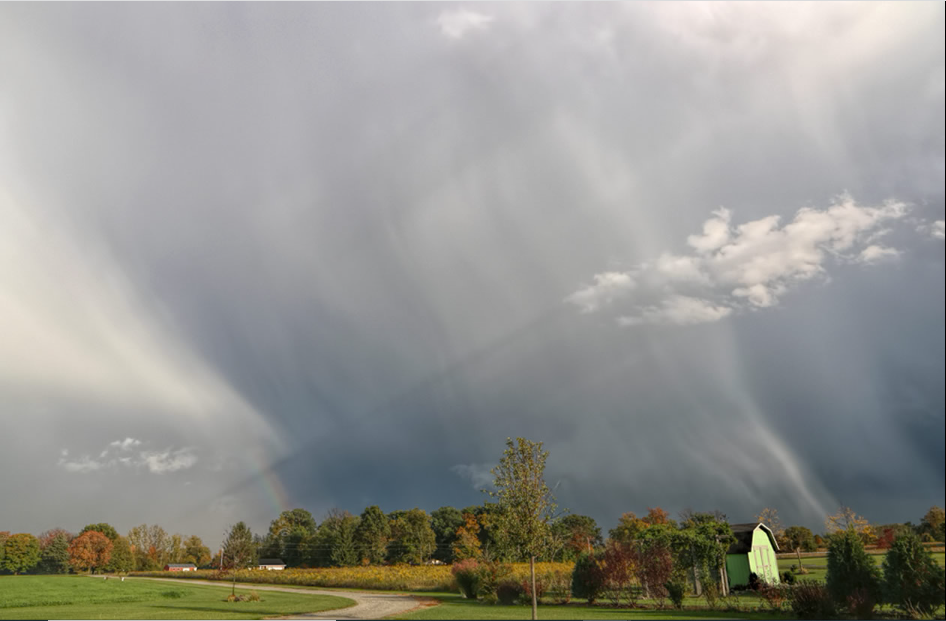Ohio Storm Clouds - OPOD
Ohio Storm Clouds - A Spectacular Display of Atmospheric Optics
When it comes to atmospheric optics, Ohio storm clouds put on a breathtaking show. With their thick swathes of rain and bursts of sunshine, these storm clouds create a mesmerizing display of natural phenomena. One such phenomenon is the appearance of a bright rainbow fragment, which seems to appear and vanish almost as quickly as it materializes.
The Dance of Light and Shadows
As we gaze upon the darkened sky, we are greeted by a fascinating sight - radial shadows crossing the scene. These shadows converge towards the bottom left, where the antisolar point and rainbow center reside. Known as anticrepuscular rays or antisolar rays, these cloud shadows add an ethereal touch to the already enchanting atmosphere. They are caused by the interaction of sunlight with the storm clouds, creating a play of light and shadows that captivates the viewer.
The Rotation of Rainbow Spokes
The interplay between the falling cloud shadows and raindrops that would otherwise form a rainbow gives rise to a unique phenomenon - rotating rainbow spokes. When the shadows fall on these raindrops, they generate spokes that appear to rotate. This optical illusion adds an extra layer of intrigue to the already stunning display in the Ohio sky.
The Ephemeral Nature of Rainbows
Rainbows have long fascinated humans with their vibrant colors and elusive nature. They are formed when sunlight interacts with water droplets in the air, creating a stunning arc of colors. However, rainbows are fleeting, appearing only under specific conditions. The presence of storm clouds and rain is crucial for their formation, making them a rare sight that fills us with awe and wonder.
Exploring Atmospheric Optics
The study of atmospheric optics delves into the science behind these mesmerizing natural phenomena. It seeks to unravel the mysteries of how light interacts with the Earth's atmosphere, leading to the creation of rainbows, halos, and other optical phenomena. Researchers and scientists continuously strive to understand the intricate processes that give rise to these visual spectacles, shedding light on the hidden secrets of our atmosphere.
The Beauty of Nature's Artistry
The images captured by Glenna Bayer beautifully showcase the splendor of Ohio storm clouds and the atmospheric optics they give rise to. Through her lens, we are transported into a world where light and shadows dance together, creating a symphony of colors and patterns. These images serve as a reminder of the awe-inspiring beauty that nature has to offer, encouraging us to appreciate the wonders that surround us.
The Importance of Documentation
Photographs like those taken by Glenna Bayer play a crucial role in documenting and preserving these transient atmospheric phenomena. By capturing these moments in time, photographers contribute to the collective knowledge and understanding of atmospheric optics. Their images serve as valuable resources for scientists and enthusiasts alike, allowing them to analyze and study these natural wonders in greater detail.
Chasing the Optics
For those with a deep fascination for atmospheric optics, chasing storms and observing these phenomena firsthand can be an exhilarating experience. Storm chasers and weather enthusiasts often venture into the heart of storm systems, eagerly anticipating the mesmerizing displays that await them. By immersing themselves in the midst of these atmospheric events, they gain a deeper appreciation for the complexity and beauty of nature's artistic palette.
A Constantly Evolving Field
The field of atmospheric optics is one that is constantly evolving. With advancements in technology and our understanding of light and atmospheric processes, new insights are continually being uncovered. Scientists and researchers work tirelessly to unravel the intricacies of these phenomena, expanding our knowledge and allowing us to appreciate the wonders of our natural world on a deeper level.
Embracing the Magic
In a world where we are often caught up in the hustle and bustle of everyday life, taking a moment to appreciate the magic of atmospheric optics can be a transformative experience. Whether it is gazing at a rainbow fragment or witnessing the dance of light and shadows in storm clouds, these moments remind us of the beauty that exists beyond our everyday routines. So, next time you find yourself under an Ohio storm cloud, take a moment to look up and embrace the enchanting spectacle that unfolds above you.

Images by Glenna Bayer. Thick swathes of rain sweep across the landscape creating in the top image a bright rainbow fragment. We can imagine that it will be gone almost as quickly as it appeared. Below: The sky has darkened but there is still sunshine. Radial shadows cross the scene. They converge towards bottom left where the antisolar point and rainbow centre lie. They are cloud shadows, anticrepuscular rays better called antisolar rays. When these shadows fall on raindrops that would otherwise form a rainbow they generate rainbow spokes that appear to rotate. Images ©Glenna Bayer, shown with permission

Note: this article has been automatically converted from the old site and may not appear as intended. You can find the original article here.
Reference Atmospheric Optics
If you use any of the definitions, information, or data presented on Atmospheric Optics, please copy the link or reference below to properly credit us as the reference source. Thank you!
-
<a href="https://atoptics.co.uk/blog/ohio-storm-clouds-opod/">Ohio Storm Clouds - OPOD</a>
-
"Ohio Storm Clouds - OPOD". Atmospheric Optics. Accessed on November 26, 2024. https://atoptics.co.uk/blog/ohio-storm-clouds-opod/.
-
"Ohio Storm Clouds - OPOD". Atmospheric Optics, https://atoptics.co.uk/blog/ohio-storm-clouds-opod/. Accessed 26 November, 2024
-
Ohio Storm Clouds - OPOD. Atmospheric Optics. Retrieved from https://atoptics.co.uk/blog/ohio-storm-clouds-opod/.